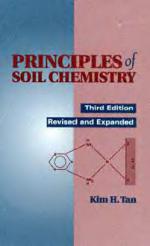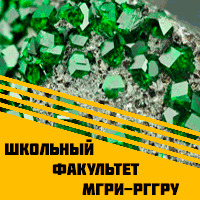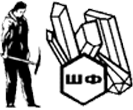Добрый день, Коллеги. Важное сообщение, просьба принять участие. Музей Ферсмана ищет помощь для реставрационных работ в помещении. Подробности по ссылке
Principles of soil chemistry / Принципы химии почв
As soon as the second edition of Principles of Soil Chemistry appeared, it was sought after by many scholars, students, professionals, and scientists interested in the chemistry of soils. It was chosen as the textbook at the University of Georgia for teaching the senior-level undergraduate and graduate course in soil chemistry. It has been used as a textbook in soil chemistry at the University of California, Davis, and other universities in the United States. Because of its simple language and style, which avoid making problems more complex than needed without sacrificing scientific standards, the book is particularly appealing as a textbook in many universities overseas. The first edition of Principles of Soil Chemistry was translated in Indonesian and published by the University of Gadjah Mada Press, Yogyakarta, under the title Dasar-Dasar Kimia Tanah, which soon sold out and is out of press. I was invited to teach Soil Chemistry and Soil Genesis courses for a semester in 1996 at the University of Andalas, Padang, Sumatra, Indonesia, and in 1995 at the Universidad Nacional del Sur, Bahia Blanca, Argentina, where my first and then the second edition were adopted as the main textbook for these courses.
This third edition is intended to make the book even more up-to-date, by incorporating suggestions and recommendations presented by a whole range of readers including teachers, professors, students, department heads, and scientists from universities in the United States, Russia, Japan, and Argentina. The organization remains the same as that of the second edition: based on a soil system composed of gas, liquid, and solid phases. However, the text is completely rewritten and most of the pertinent theories, both inorganic and biochemical, are included. Based on these theories, new bold concepts have been adopted or developed, highlighting the relation between inorganic reactions and biological activities of importance in our fragile environment. Such a relationship, which makes this third edition unique, has never been included in other books, which are always based on inorganic chemistry. Many original figures have been added to illustrate the new concepts. Forty percent of the book is made up of new material, enabling it to meet the challenges through the first part of the twenty-first century.
Regretfully, some suggestions could not be incorporated due to either limited space or the remote relationship of the topic to soil chemistry. Not only can a soil chemistry book be written in different fashions, but in the past a variety of topics in agricultural chemistry, soil analysis, fertilizers, clay mineralogy, chemistry of soil constituents, colloid chemistry, geochemistry, and the like were considered to be soil chemistry in the United States and Europe. Identifying soil chemistry as physical chemistry, as is done by some graduate students, is like identifying soil science as geology. The term Agrogeology has been used for the latter in Europe. Soil chemistry, the youngest branch of soil science, has developed its boundaries only recently from related chemical and soil sciences, just as soil science has carved its identity from chemistry, geology, and related earth sciences. It started to crystallize in the 1970's, and the real giants in soil chemistry are, therefore, not known yet, though many soil scientists can be mentioned who have contributed significantly to some aspects of soil chemistry. The book Soil Chemistry, edited by G.H. Bolt and M.G.M Bruggenwert (Elsevier, 1976), and another book under a similar title authored by H.L. Bohn, B.L. McNeal, and G. A. O'Connor (Wiley, 1979), paved the way for providing the identity of soil chemistry as a science. The major topics of adsorption, fixation, cation and anion exchange, soil reactions, chelation and complexation reactions together with electrochemical properties of soil inorganic and organic constituents provide the key elements for soil chemistry as a science. Each topic can become the material for an expanded treatise on the subject, such as, for example, The Soil Reaction (an expanded version is available under the title Soil Acidity and Liming, edited by Fred Adams, Agronomy Series No. 12, American Society of Agronomy, Madison, WI). As indicated by the title of my book, only the principles or key elements are discussed here, leaving to other interested scientists to expand each subject into a detailed treatise.
The first chapter, which provides basics pertinent to the other chapters, has been enlarged in the third edition by including the newest material available on supercolliders, the modern machines for producing elementary particles. The importance of elementary particles in building the atomic nucleus and the atom is highlighted. The practical applications of neutrinos in earth and sea explorations are added as a brief but comprehensive assessment of the GENIUS, GEMINI, GEOSCAN, and LUNASCAN projects. Atomic mass, mass unit, and weight have been redefined more clearly and the transformation of matter into energy according to Einstein's famous formula has been reexamined. The issue of equivalent weight versus the units used by the SI system has also been addressed.
Chapter 2 contains new additions to cover the most recent advances in soil chemistry. Eight sections have been added to tie together the topic of electrode potential with electron activity (pe). The pe-pH relation is connected to the biochemical cycle, and a new concept (rH) is added. The importance of pe and potentials (EJ in biological systems, especially in relating them to the function of photosynthesis, gives this chapter a unique character, highlighting for the first time the connection between soil chemistry and biological activities.
Chapter 3 is enlarged and more details on soil fabric, cutans, and argillans are now provided, showing more clearly the relationship of soil components with a soil fabric. The additions of soil air quality and soil air humidity warrant the use of the new title "Soil Air" for section 3.2, whereas new topics on the approximation of soil solution and the effect of the gas phase on soil water make section 3.3 more comprehensive. The section on soil water potentials is also enlarged to include new theories, assessing the relation between water potential and water content and relative humidity, which are of importance in soil microbial activities.
Chapter 4 is completely rewritten to include the newest advances. A new section about humus is presented and the accumulation of its components and their interactions to form humic matter are addressed. The environmental importance of plant residue or litter, especially carbohydrates, in the production of biofuel is examined, because of the increased interest in pursuing ways to harvest fuel from U.S. farmlands. The importance of amino acids, lipids, nucleic acids, and lignins in soils and the environment is featured in new subsections. The section on humic acid has been overhauled to highlight its colloidal behavior and complex reactions, and the most recent advances in characterization of humic acid by atomic force microscopy are included.
Chapter 5 has also new material, such as the concepts of proton charge, ZPPC and ZPNC, which perhaps amount more to making the electrochemical properties complete than making the material more practical.




